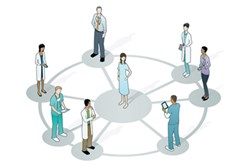Patient-Centric Design: The Next Frontier In Drug Delivery
By Ed Miseta, Chief Editor, Clinical Leader
Patient-centric is one of those terms we suddenly seem to hear mentioned often. Everyone in pharma wants patients to know that it’s their comfort and well-being that are always at the forefront of development efforts for medicine and delivery devices.
But true patient centricity is not about saying the right things at the right time. Nor is it thinking about the patient only when it comes time to present a product to them. Rather, it involves thinking of the end user at the very beginning of the discovery process, and keeping them in focus throughout the product development cycle.
 Ralph Lipp, president and CEO of consulting firm Lipp Life Sciences LLC, has been advising clients on the importance of a patient-centered approach for years. He believes that when developing novel drugs, it is even more important to keep the patient in mind, as that focus will drive everything else involved in the drug development process.
Ralph Lipp, president and CEO of consulting firm Lipp Life Sciences LLC, has been advising clients on the importance of a patient-centered approach for years. He believes that when developing novel drugs, it is even more important to keep the patient in mind, as that focus will drive everything else involved in the drug development process.
“When it comes to patient-centered drug delivery, topics like safety, minimization of side effects, and efficacy are all important topics in the development process,” he says. “But some in the industry fail to understand that portability, social acceptability, and a good understanding of how patients interact with the delivery device are topics that must also be considered. A better understanding of patient-centric drug delivery will lead to better patient outcomes, which is clearly the overall goal of what we do.”
Lipp defines patient centricity as thinking of the patient at each and every phase of the development process. It involves moving beyond the most basic patient needs of safety and efficacy, and thinking about the entire spectrum of patients who may be using the drug, and what their needs are. When dealing with medicines that must be self-administered, the human factor will have to play an even greater role in the area of drug and device development. Easier self-administration will lead to greater patient adherence, which in turn will significantly support reaching the ultimate goal of improved patient outcomes.
Adherence Equates To Success
The advantages of patients being able to self-administer a drug are many. First, it will cut down on the amount of time a patient must spend in a hospital or clinic. Patient-friendly devices mean medicines can be administered at home, whether by the patient or a nurse or home care professional. For example, Kurt Nielsen, CTO and SVP of R&D at Catalent, notes being able to self-administer an anticoagulant at home can knock two days off a fiveday hospital stay, resulting in a savings of thousands of dollars.
Nielsen also believes a significant value of the patient-centric approach lies in adherence. “If patients understand why they need to take medicines, they are more likely to take them,” he says. “Only then is the magic of the drug able to happen.
The more difficult the process of self-administration, the less likely it is to happen. And when patients stop taking their medicines, the magic can’t happen.” To increase acceptance, there are several factors to consider. Lipp starts with invasiveness. “Users will more readily accept a medicine that is administered via a device that is comfortable to handle and easy to self-administer,” he says. “With age, self-administration becomes one of the greatest challenges patients face. In addition to dexterity issues caused by the onset of arthritis in some patients, there will be challenges created by the deterioration of vision in other patients. Packages and devices with small writing and multiple steps that need to be performed will result in lower acceptance rates.”
When developing the device and the labeling, Nielsen recommends catering to the lowest common denominator. For example, if a portion of the target audience might have difficulty reading, that factor has to be considered when designing the instructions. “There is not a lot of customization for the different patient populations,” he says. “I have yet to see anyone produce a pen for a patient in their 20s and another one for patients in their 60s. We may see more of that in the future when companies get more involved with addressing patient subpopulations, but until then we need to do whatever possible to minimize side effects and maximize adherence for all potential patients.”

A better understanding of patient-centric drug delivery will lead to better patient outcomes, which is clearly the overall goal of what we do.
Ralph Lipp, President and CEO of Lipp Life Sciences LLC.
Start Thinking About Patients Early
To ensure patients are a primary concern throughout the development process, they should be a consideration from the very start. “Depending on where a drug is in its life cycle, decisions on technology design should be part of the initial drug development strategy or as soon as the need for reformulation is identified,” notes Robert Becker, chief research officer for Aptalis Pharma. “Of course, we need to ensure a drug is effective and tolerable, but if it can’t get to where it needs to go because patients can’t tolerate it, or it is delivered in an inefficient dosage form—it is not going to achieve its intended clinical goal.”
When it comes to decisions about drug delivery technology, time is of the essence. Becker believes incorporating the most appropriate drug technologies from the start also helps optimize life cycle management, making the most of the drug at every stage. “Ultimately, this will enable the drug to bring more value to the patients who use it and greater profitability to the company that makes it,” he adds.
One way to make sure all patient considerations have been taken into account is to prepare a list of questions to be asked throughout the process. The first question should obviously ask what patient population will be using the device. Once that is known, determine if there is already a device on the market that is appropriate for that population and is readily available. “You can’t use a pen that was designed for diabetics needing insulin and expect it to be used by an elderly patient with rheumatoid arthritis,” says Lipp. “However, if there is already a device available tailored to the needs of arthritis patients, it would make sense to use that device. Then you can build on it going forward if you believe there are improvements that need to be made. Of course if a device is not readily available and the target population cannot easily handle a prefilled syringe, then a more sophisticated device should be considered.”
There is enough risk in showing the safety and efficacy of a drug. For many executives, laying an additional layer of risk on top of that goal would be a step in the wrong direction.
Kurt Nielsen, CTO and SVP of R&D at Catalent
Go To Market Or Wait?
A dilemma faced by many pharma companies is whether to get a drug to market as quickly as possible or wait until a better delivery device is developed. If a medicine can be put on the market quickly, it is good for patients who need the drug, and it provides a quicker economic return for the firm. But releasing the drug with an inappropriate delivery device could also cause the whole effort to backfire.
This is a decision moment that must be considered, and there are two schools of thought. “If there is a similar drug already on the market with a sophisticated device, are you willing to go into that market with a new biologic and an inferior delivery device?” asks Lipp. He recommends taking a close look at the market to see what medicines are already available, along with the devices available to deliver them. One should only go ahead quickly if the new biologic/ device combination-product offers patients advantages over already existing combination-products, otherwise one should consider further investment into device optimization.
Unfortunately, this approach may also create additional risk. Nielsen believes many manufacturers will have a different perspective. “When you are in clinical development, the goal is to demonstrate the safety and efficacy of the drug; everything else is secondary to that,” he says. “Once you launch it and get some clinical experience with it, only then will most companies look at the product to consider how they can make it better. Companies have a lot to worry about when submitting a drug for FDA approval. Once they prove the safety and efficacy of the drug to the FDA and payers, they may go back and make incremental improvements or breakthroughs with the device, but not until after the approval.”
Including the device design step into this process, and proving that it works in a clinical study, certainly entails taking on an additional risk. According to Nielsen, that is a risk 9 out of 10 companies would likely not want to take. “There is enough risk in showing the safety and efficacy of a drug,” he adds. “For many executives, laying an additional layer of risk on top of that goal would be a step in the wrong direction.”
Will The Payers Be Willing To Pay?
Even if you develop a safe and effective drug in a delivery device appropriate to your patient population, there is no guarantee insurance companies will be willing to pay for it. Becker believes payers in the U.S. and around the world are looking for measurable improvement in patient outcomes as the criteria for new device acceptance.
“The trend among payers is to look more comprehensively at the range of benefits a drug provides to the health of patients and the economic impact of a disease,” he states. “If we are improving adherence to a drug with our technologies, patients can better manage their conditions, and the cost of care goes down. Insurance companies want to be able to measure that improvement. If we can show them how much of an impact patient-centric dosage formulations can have, they will be more apt to reimburse more of the cost. They just need to recognize the value the medication and the delivery method brings.”
Nielsen agrees payer coverage is an industry concern. Still, he believes it can be easy to overcome. “If patient adherence is 50 percent when using a prefilled syringe, and your studies show adherence to be 80 or 90 percent with a new device, that will cause the payers to take note,” he adds. “Payers will ultimately benefit from the patient having fewer relapses, fewer emergency situations, and fewer hospital and home care visits. If the device costs an additional $5 or $10, but the savings to the insurer is in the hundreds or thousands, that is something you can quantify. It is an economic argument that is easy to make, but you need to have the data to prove it. Managed care is built on the premise that if you have the right interventions with physicians and are taking medications, symptoms can be alleviated without hospitalization or emergency care. That is the primary reason for having devices patients can use to self-administer, and which they will continue to use in the future.”
